Made in Sai Ying Pun; Explore the Neighbourhood Through the Eyes of Local Craftsmen
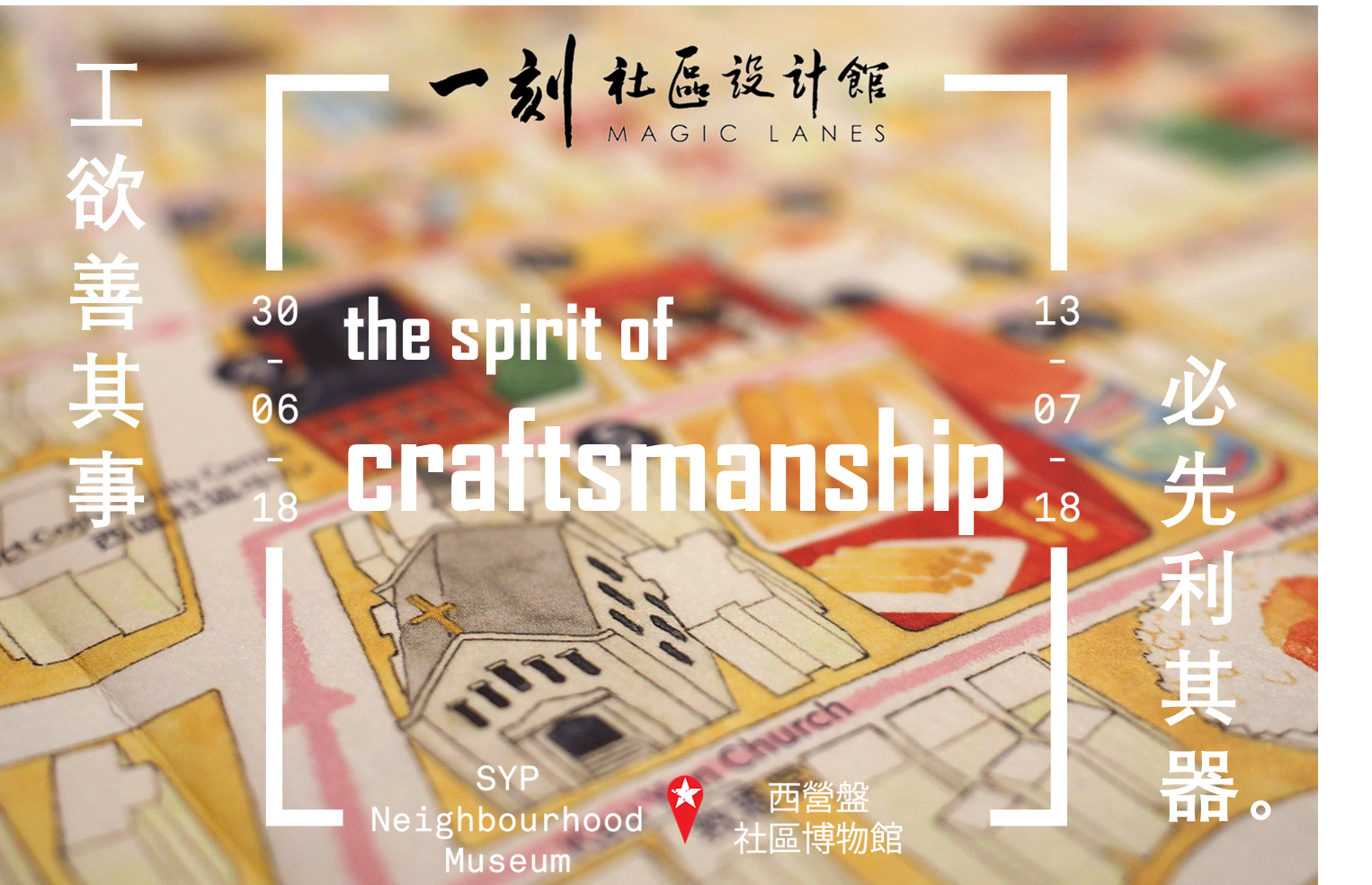
Sai Ying Pun (or SYP), Hong Kong‘s new hotbed of urban cool, is at its heart still a low-key traditional neighbourhood with dried fish, neon signs and lots of old men in white vests hanging out at the local tea house. Dig a bit deeper and you find old-school craftsmanship around every street corner. You see artisans at work in small workshops and tucked-away factories. Not the type of art & craft advertised in glossy travel magazines, but the honest home-grown skills of hardworking men and women who produce things the way locals like it; the traditional way. In this tight-knit community, the skills of woodworkers, bamboo crafters and joss-paper makers are still much in demand. Here, ancient noodle and biscuit recipes are treasured like gold and you can even find Hong Kong oldest soy sauce factory. Meet eight SYP craftsmen and experience SYP’s proud and unique culture through their eyes and their hands.
In Sai Ying Pun you can still find old craftsmanship around every street corner.
We visited eight local craftsmen in Sai Ying Pun to learn about their trade, their favourite tools and what makes them proud. See what they create; learn what they love; feel their passion and find out about their most precious tools and how you can help sustain these local businesses and keep heritage alive.
1. Mr Lam . Tuck Chong Sum Kee Bamboo Steamers

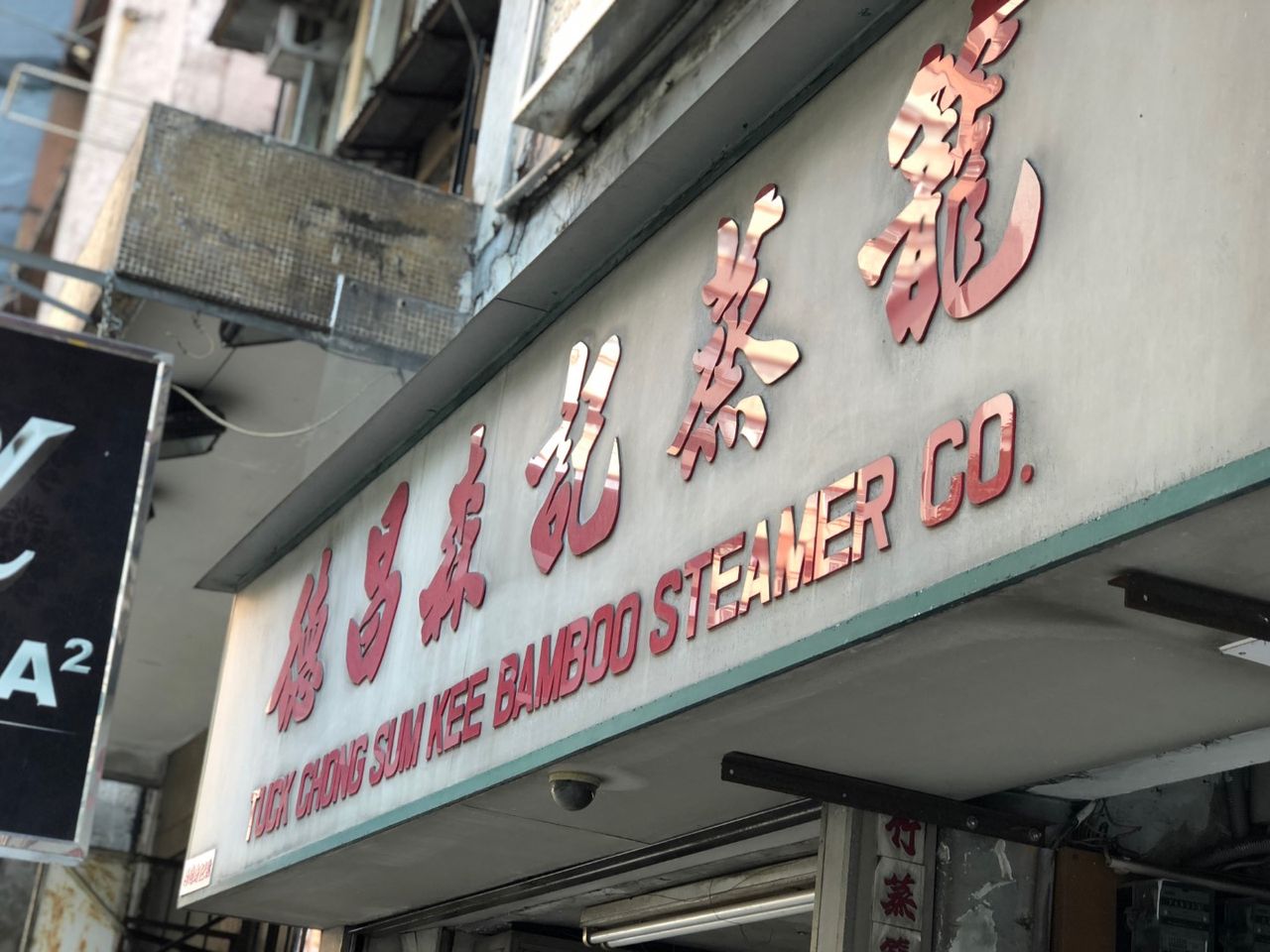
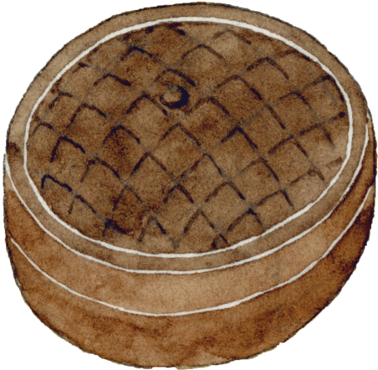
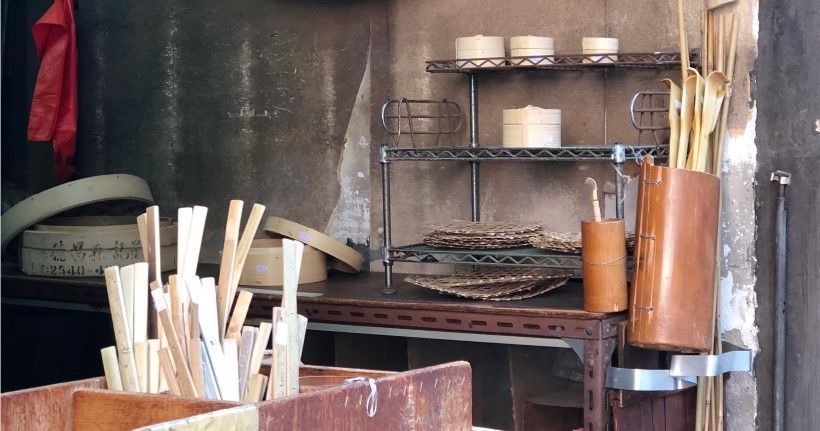

Story - Steaming Baskets
Tucked away in a Sai Ying pun side street you find one of the last remaining places in town where bamboo steamers are still made by hand. Mr Lam’s family has been making bamboo cooking utensils for five generations, stretching all the way back to his great-great-grandfather, who travelled between village markets in Guangdong.
Dim sum so synonymous with Hong Kong’s culinary culture, is all about bamboo baskets. Steaming helps to capture the moisture and the bamboo scent also gives the dishes their distinct flavour. "There was a time when metal steamers became popular, but they quickly went out of fashion when chefs realised the metal taste was detectable in the dim sum." says Mr. Lam "now most restaurants insist on using bamboo steamers to bring out the authenticity and freshness of the food."
It takes about three years to learn how to hand-make a steamer from a single piece of bamboo.
Business was very good in the 1960s -70s with Hong Kong’s restaurant scene thriving. "We were producing baskets for places all over town and had lots of custom orders. When dim sum developed into different shapes and sizes, we also had to produce different size steamers. In addition to the 21-inch original we now have 17 types." he says. ‘We even used to hang the bamboo steamers on a thick leather strap so that waitress could carry them around her shoulders to sell the dim sum".
"It takes a lot of skill. You need to learn how to split the bamboo, how to polish it, how to make bamboo pins and how to knit the bamboo into a basket shape." says Lam. “It takes about three years to learn how to hand-make a steamer from a single piece of bamboo.” Mr. Lam uses a solid block of timber as a workbench. "In the 1950s, Singaporean timber was imported to Hong Kong for foundation piles. It is very strong, I use it as a workbench to flatten the bamboo sticks."
Tool - chopping block
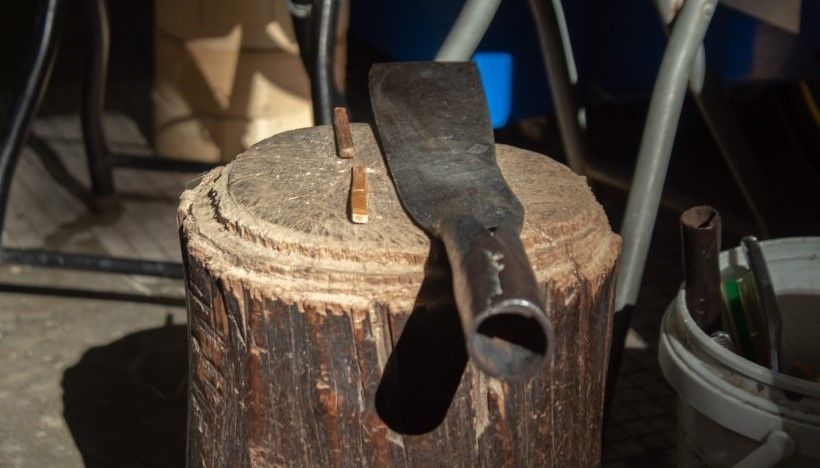
Buy - Steaming Basket
Stock up on steamers large and small. Or why not buy a wooden mooncake press, a set of handmade spoons or a ginger grater?
Tuck Chong Sum Kee Bamboo Steamers . 12 Western Street . 德昌森記蒸籠 . 西邊街12號
2. Mr Man . Chi Loy Heung Eggrolls

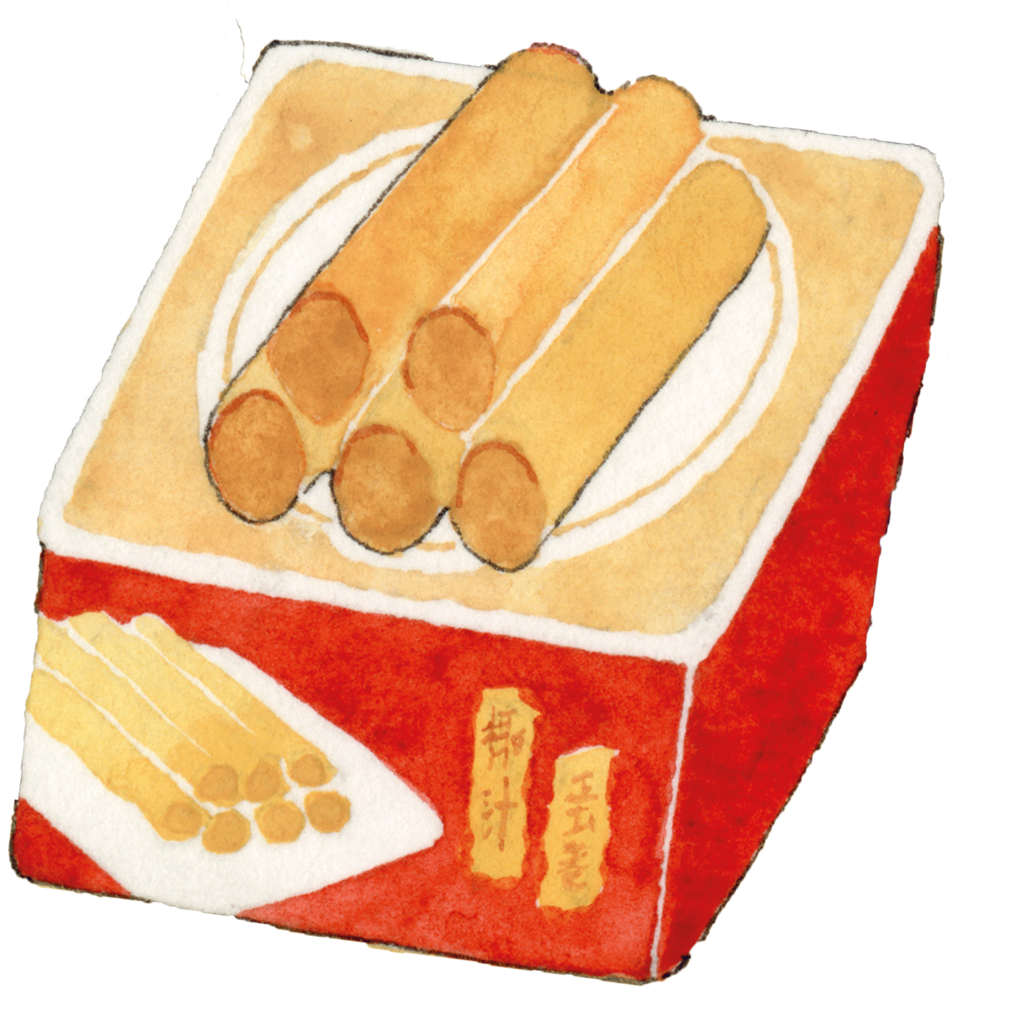
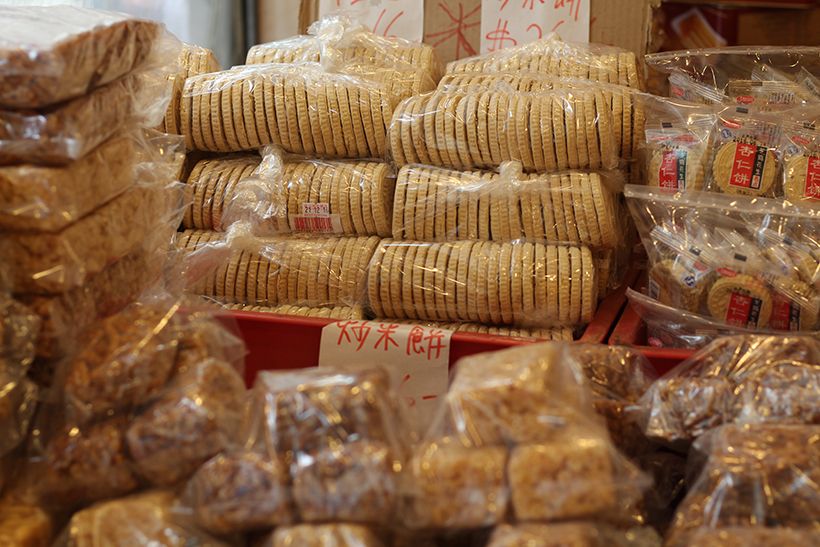
Story - Steep Slope
'Egg rolls on the slope’ is how many locals still know this small Sai Ying Pun bakery. The name dates back to the pre-escalator days when the steep slope was more of a hard-to-get-to place. With the construction of the MTR and escalator Arona was among the shops that moved into the new market. Maybe it was because people couldn’t smell the rolls anymore, but business went bad and within 3 months Arona was back on the street, this time at Third Street.
We bake our egg rolls fresh every day, here at the back of the shop.
To make the sweet flaky biscuits Mr Man mixes butter, flour, eggs and sugar and adds a hint of vanilla. The mixture is spread onto an old-fashioned iron steel press, baked until golden crisp and then rolled around an iron stick. The secret is to make sure the press has the right temperature so the dough spreads easily but doesn’t burn. "We are famous for our eggrolls. We even created a special tin container, so they can stay fresh." says Mr Man.
Tool - Iron Steel Press
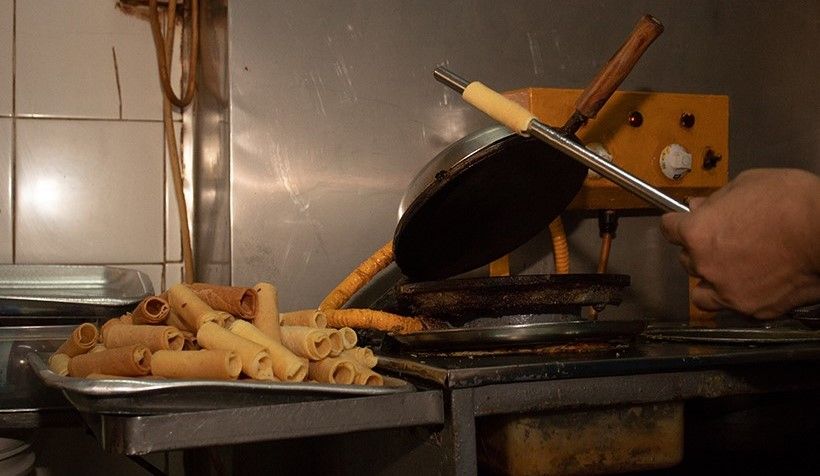
Buy - Egg Rolls
How can you not love the egg rolls? They’re fresh and flaky and the tin box also makes for a great gift. But Chi Loy Heung has a lot more to offer! Pick from a range of traditional cakes and biscuits with some unique flavour combinations like lemon, winter melon and rice crispy.
Chi Loy Heung Eggrolls . 66 Third Street 齒來香蛋卷第三街66號
3. Mrs Eng . Eng Kee Noodles
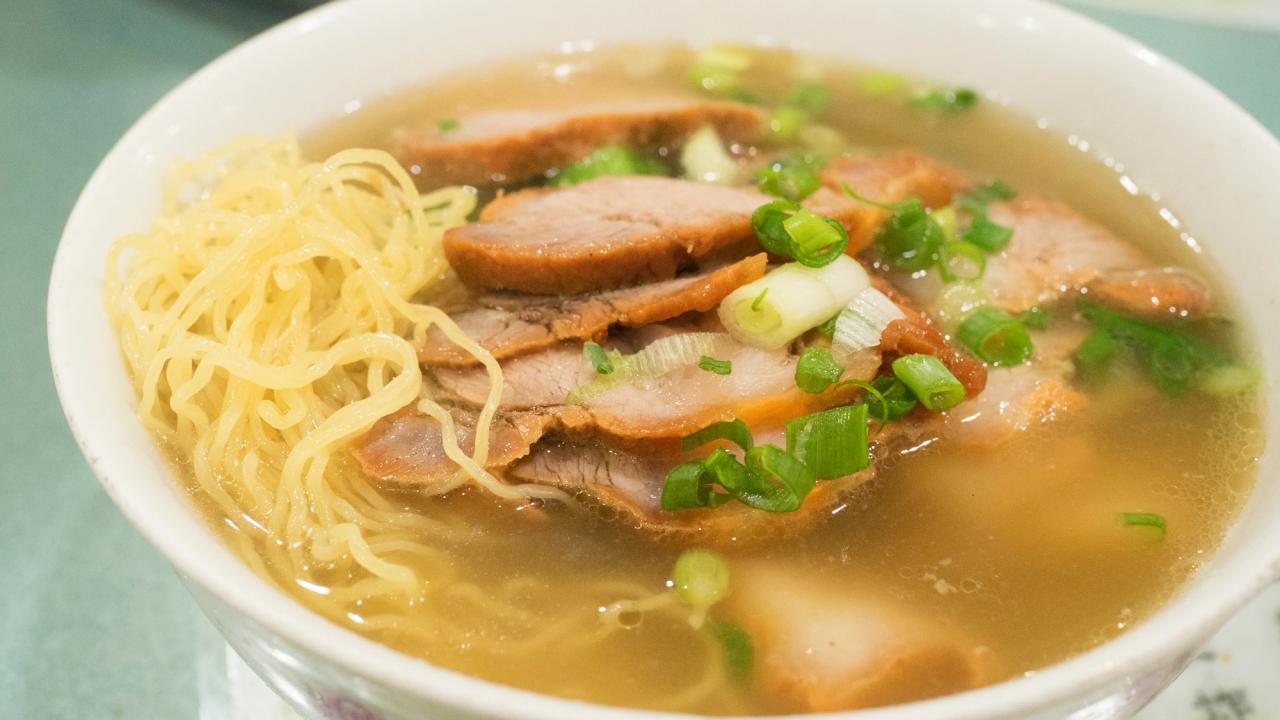
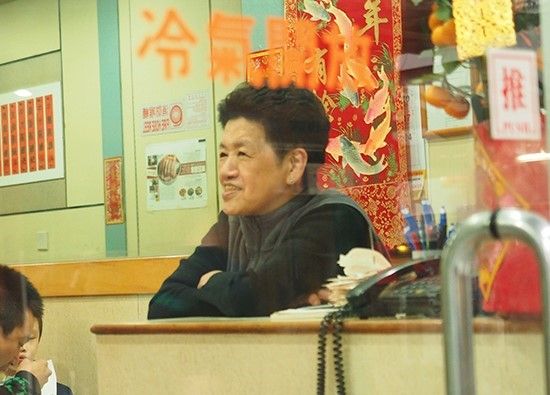

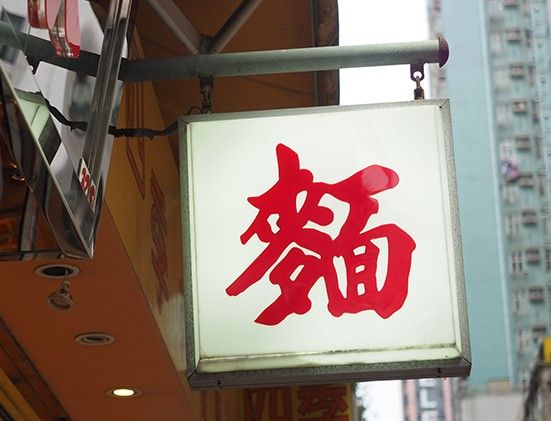

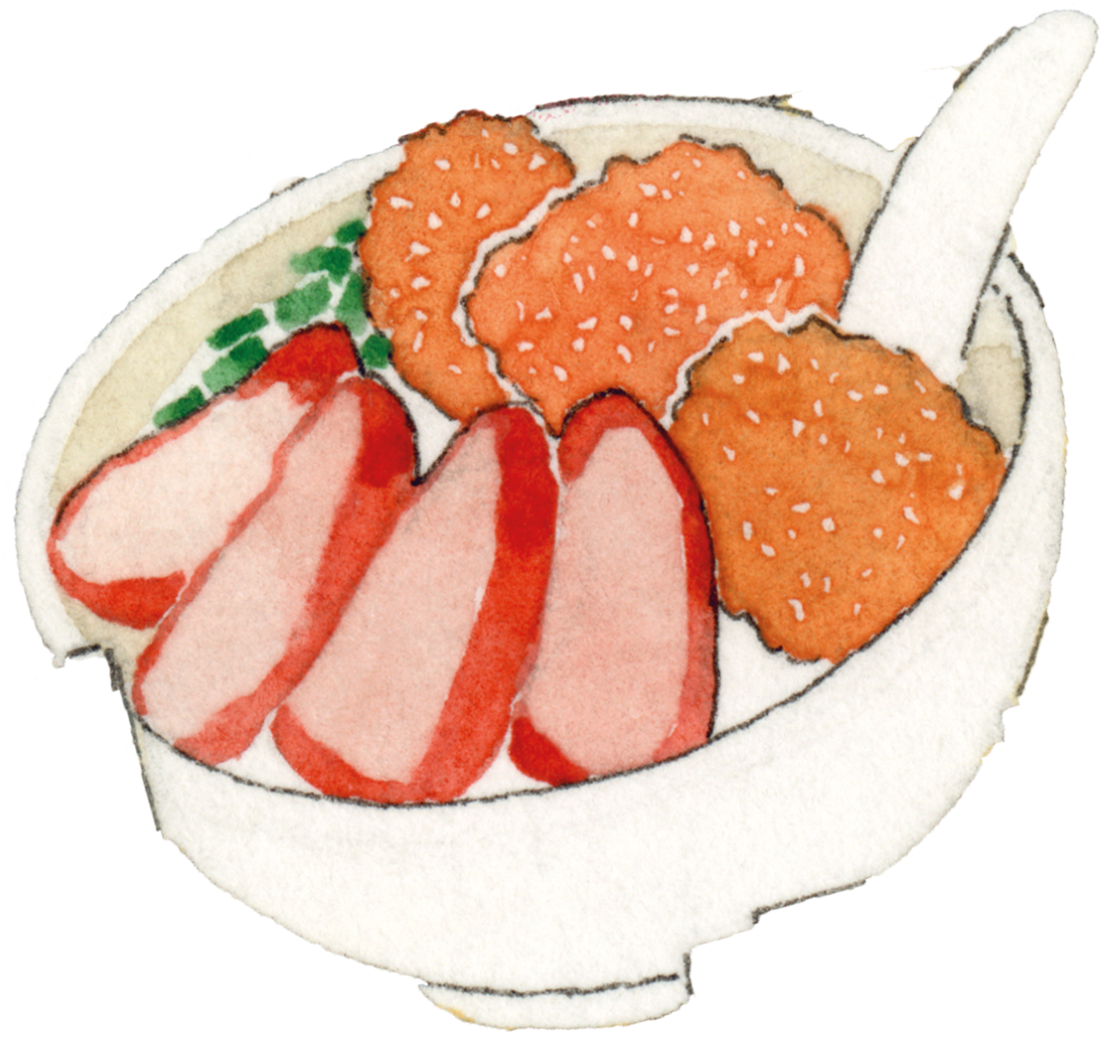
Story - Noodles by the sea
“We used to be one of the many food stalls at Centre Street. In those days you could see the sea from there and many locals still refer to us as ‘noodles by the sea” says Eng owner of Eng Kee a popular Sai Ying Pun eatery specialises in authentic Cantonese barbecue flavoured cha siu. So popular it gained a place in the 2018 Michelin Guide. For 23 years, this tiny shop has been feeding hungry locals. The family business prides itself on its signature beef brisket - braised overnight in a spiced marinade to bring out the meat’s silky tenderness and deep flavour. Instead of the shoulder, their oven-grilled cha siu is made with the succulent pork neck, known for its fine marbling. Preparations start every day at 6am, using only fresh local ingredients. Be quick, the popular pork dumplings usually sell out by 3pm.
We did know how to cook decent cha siu noodles but to find a name for the shop was a bigger challenge.
Eng is Singaporean who grew up in Brunei. She moved to Hong Kong in 1985 following the love of her life. She worked for a while in his uncle’s restaurant before they decided to open their own noodle shop. “We did know how to cook decent cha siu noodles but to find a name for the shop was a bigger challenge. My husband is chubby, so I thought of Fai Jai (Fat Boy), but he suggested using my name, that’s how we ended up with Eng Kee.”
Tool - Steel Knife
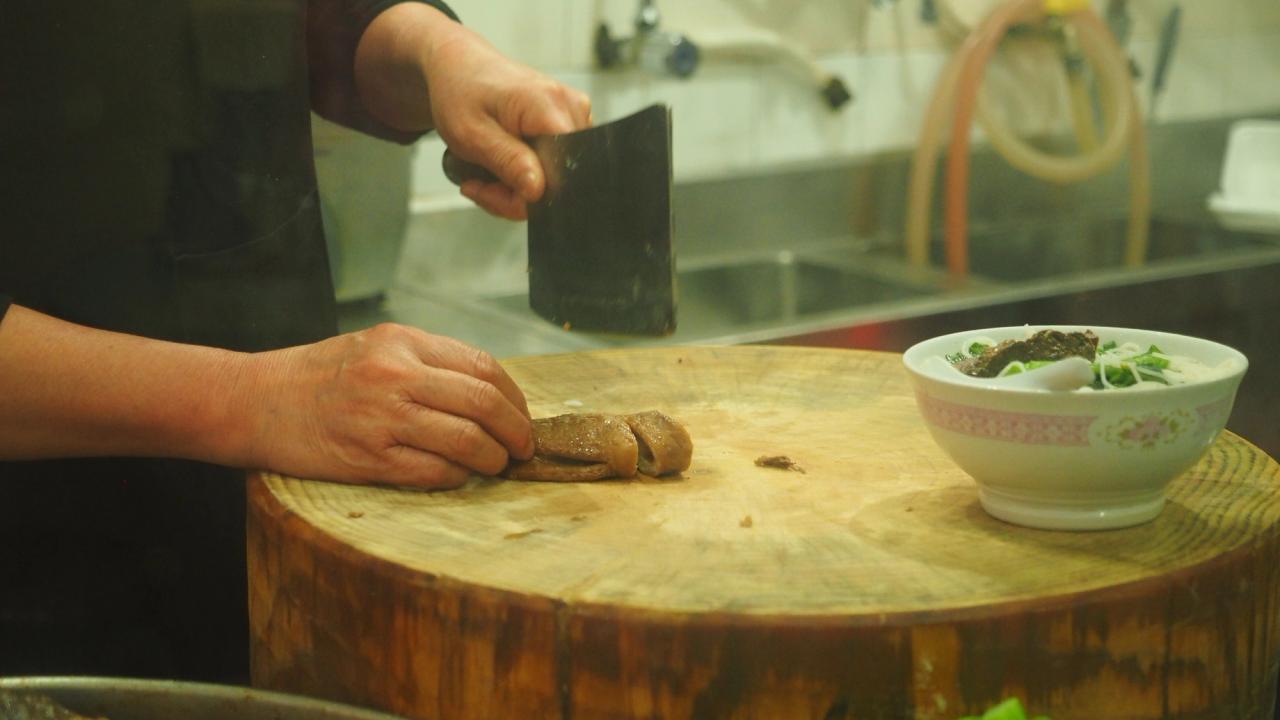
Buy - Cha Siu Noodles
People come from far and away for the unique home-made Cha Siu noodles, easily the most popular item on the menu. It’s the dish that sets this place apart. The fried dumplings also come highly recommended. Try them with some home-made chili sauce.
Eng Kee Noodles . 32 High Street 英記麵家高街32號
4. Mrs Kwan . Kwan Hing Kee Tofu

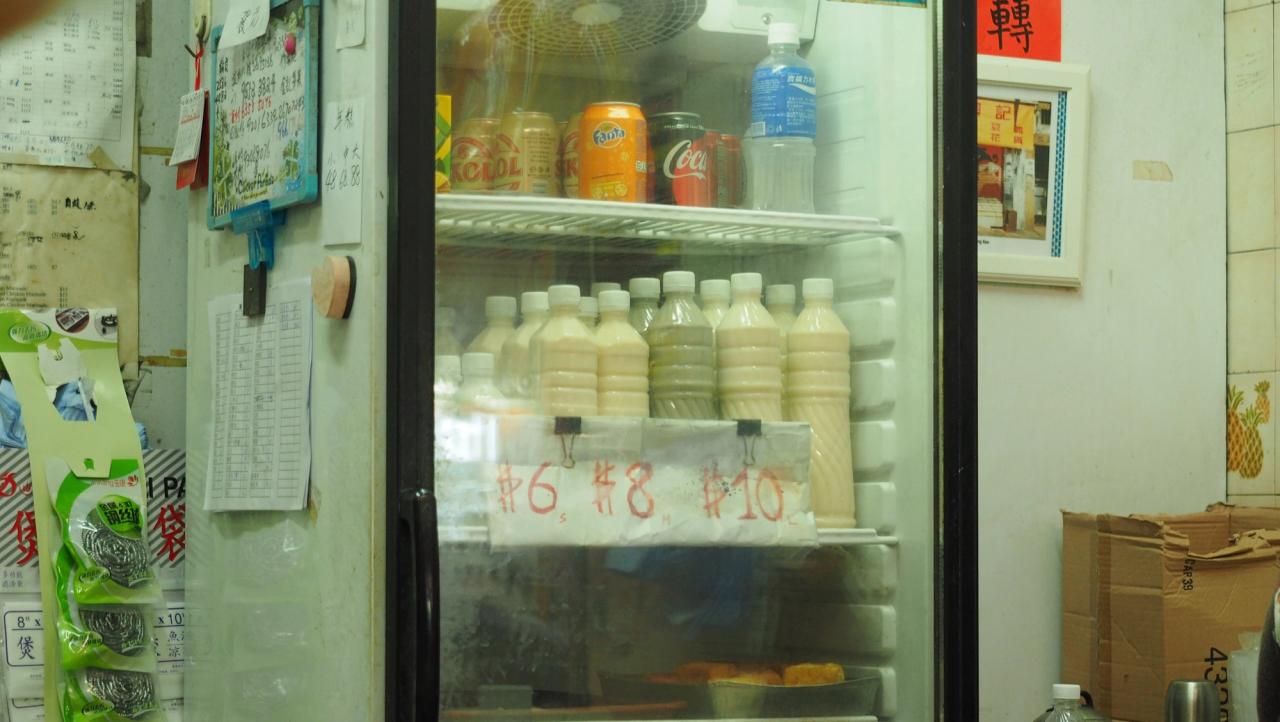
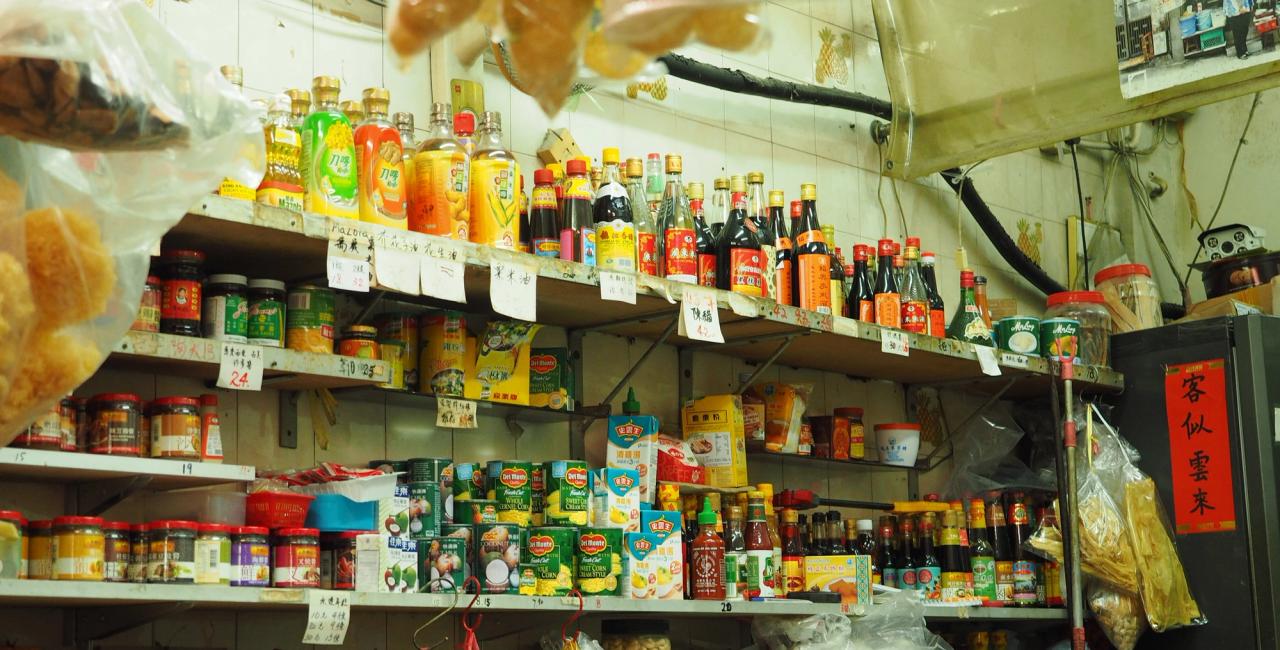
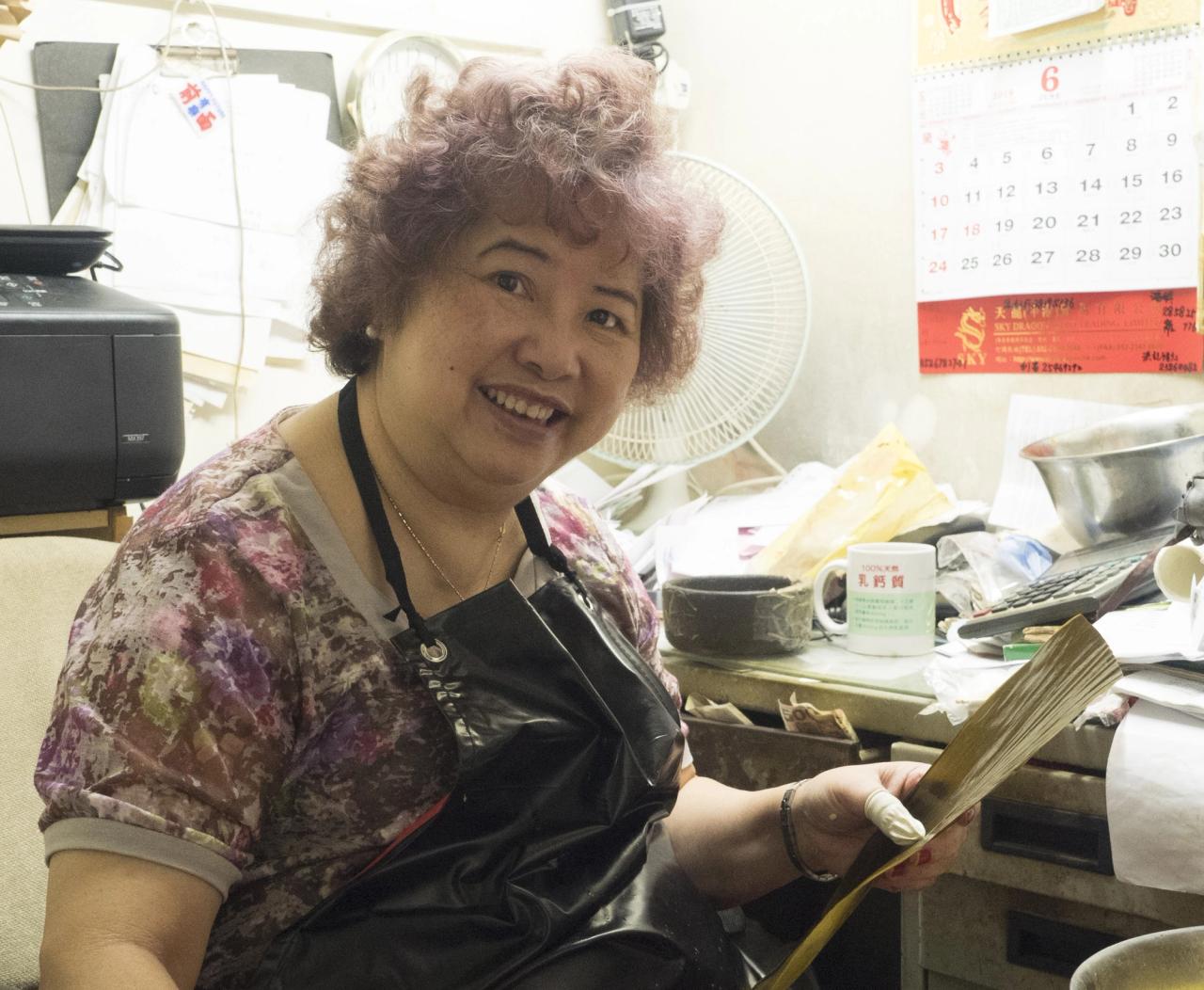
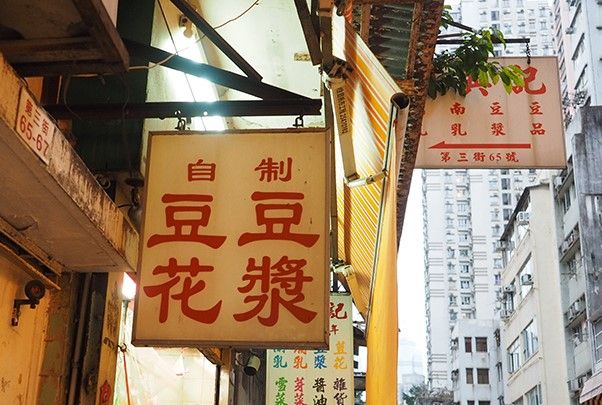
Story - Here to Stay
I want to keep the price low and quality high.
This local family store has been in Sai Ying Pun for 90 years. It all started with the old Mr Kwan selling bean curd from baskets on a bamboo pole until he made enough money to open a shop, first on first street, later here on 3rd Street. Business wasn’t always easy, during the Centre Street reconstruction they nearly went bankrupt, but survived by exporting fermented bean curd sauce. The secret to the right tofu texture is in the balance between water and soy beans. "I don't sample every single bucket, but I can tell instantly whether the tofu is soft or not."
Mr Kwan’s daughter now operates the business. "I want to keep the price low and quality high. I get contacted all the time by developers who want to buy this place, but I always say no. I hope to pass on the family business to my son."
Kwan Hing Kee also makes its own ginger juice to add extra flavour to the tofu pudding and introduced special products for festive occasions like rice dumplings for Tuen Ng Festival, handmade in different flavour combinations and wrapped in bamboo leaves.
Tool - Bamboo Wrappers
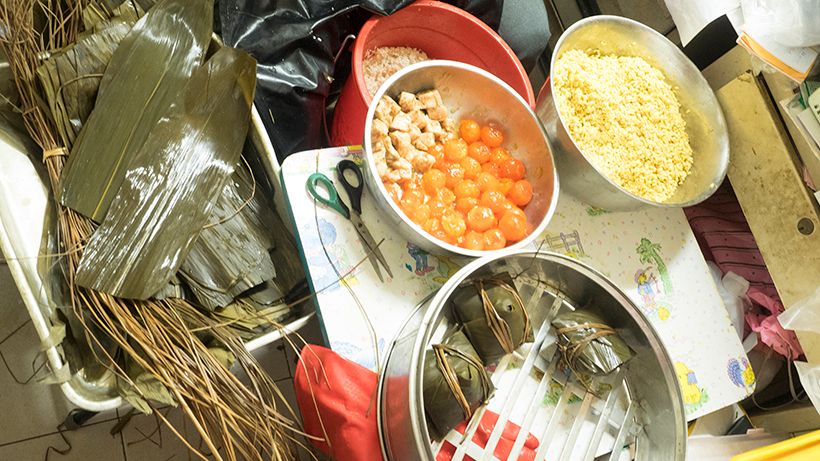
Buy - Soy Milk
For a true local treat, have a cold glass of soy milk or a bowl of silky tofu pudding, a light, creamy dessert that is refreshing on a hot day and heart-warming on a cold one. Or pick up some house-made soy bean and fermented tofu paste for your Cantonese culinary adventures at home.
Kwan Hing Kee . 65 Third Street . 關興記 . 第三街65號
5. Mr Lee . Lee Zam Kee Tailor

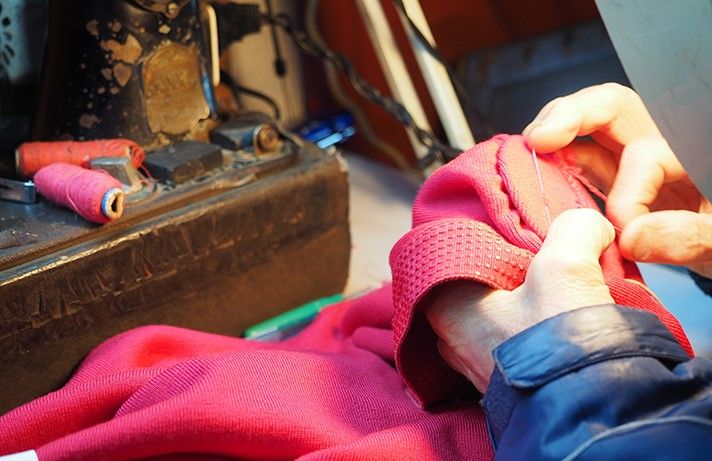

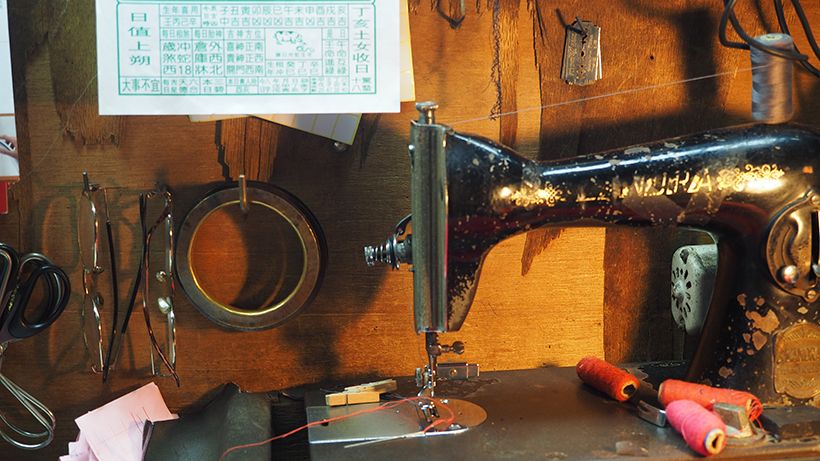
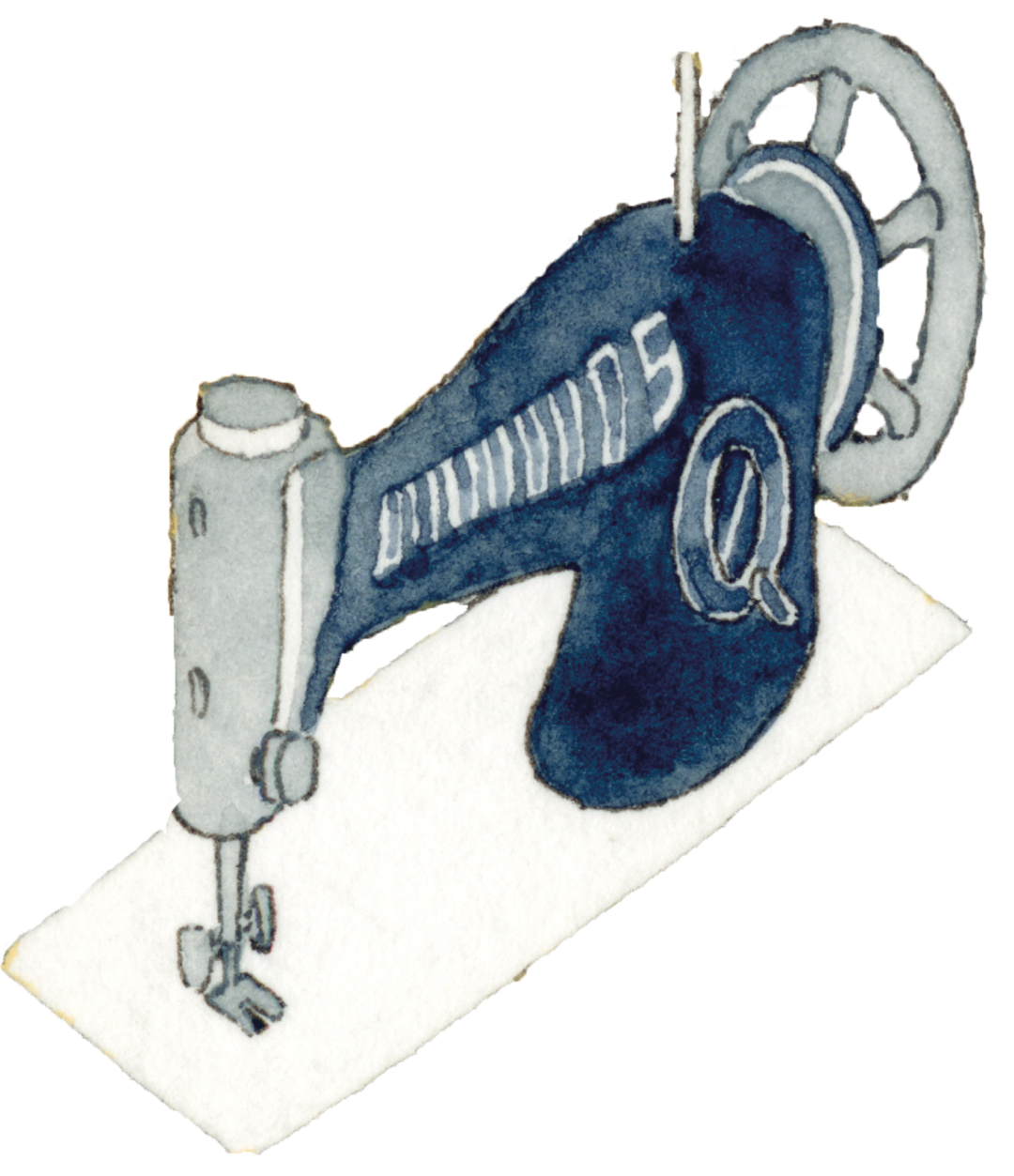
Story - Vintage style
If you walk fast you might juts miss this tiny shop tucked away in a small lane off Eastern Street. A typical Hong Kong neighbourhood tailor shop, Mr Lee likes things the traditional way. He still operates a vintage Singer sewing machine and his magnifier, glasses, scissors are all originals. “I use a bronze ring to hold the fabric, so that the needle and thread pass through easily, just like an embroidery frame.” Mr Lee has never thought of leaving the shop “Except when I got a cataract, but I felt better after the operation and will continue knitting and fixing as long as I can."
Mr Lee followed his father’s footsteps who started the shop in 1940 on Eastern Street. He remembers the golden days: "The busiest times were 1950s & 60s, stockings were the most popular item in the shop! They were super expensive back then so people couldn’t afford to buy brand new ones and they would bring them here to get the holes fixed." He says. "Sometimes pawn shops would bring clothes that no one claimed so I could repair and sell them".
The busiest times were 1950s & 60s, stockings were the most popular item in the shop!
Tool - Fabric Ring

Buy - A New Zip
Mr Lee will fix your worn clothes, whether it’s a hole, a zip or a button. The price varies depending on the fabrics, texture, patterns and size. No job is too big or too small.
Lee Zam Kee . Ng Fuk Lane . Eastern Street . 李湛記織補 東邊街五福里
6. Mr Ng. Ng Wai Kee Salted Fish
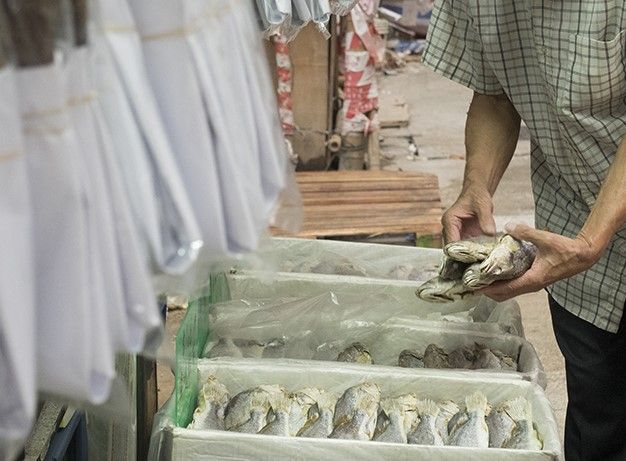

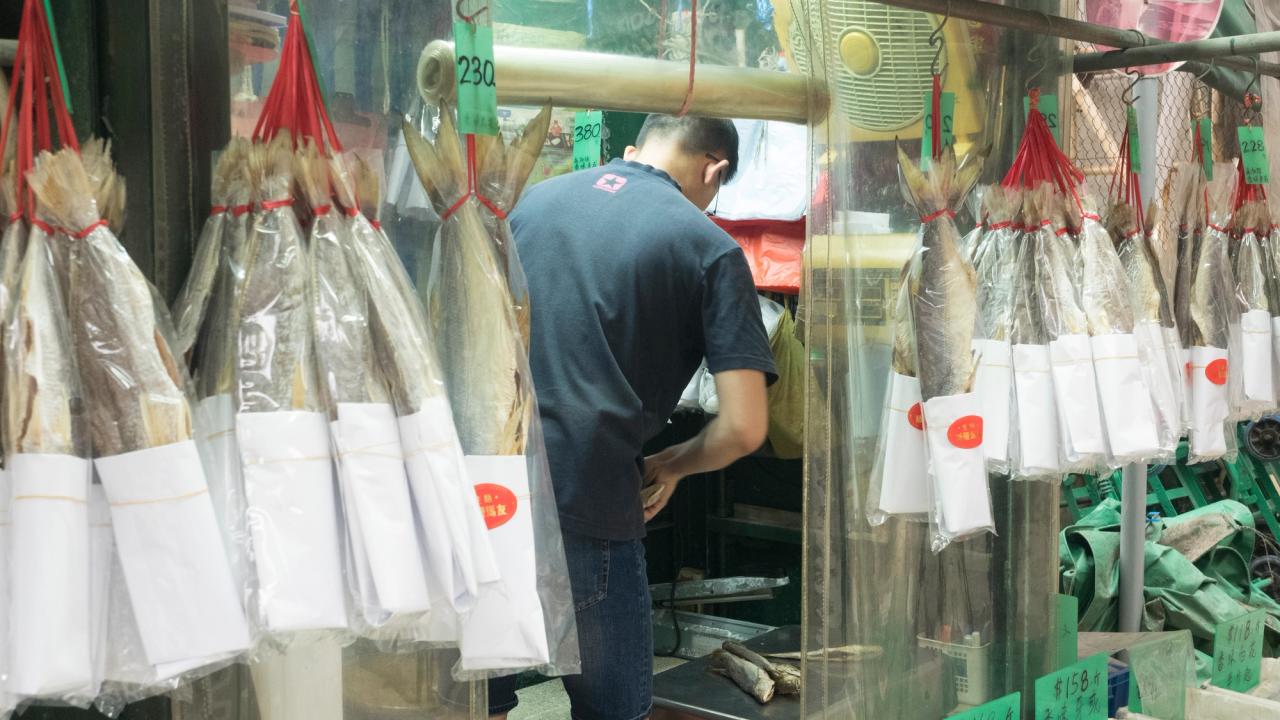
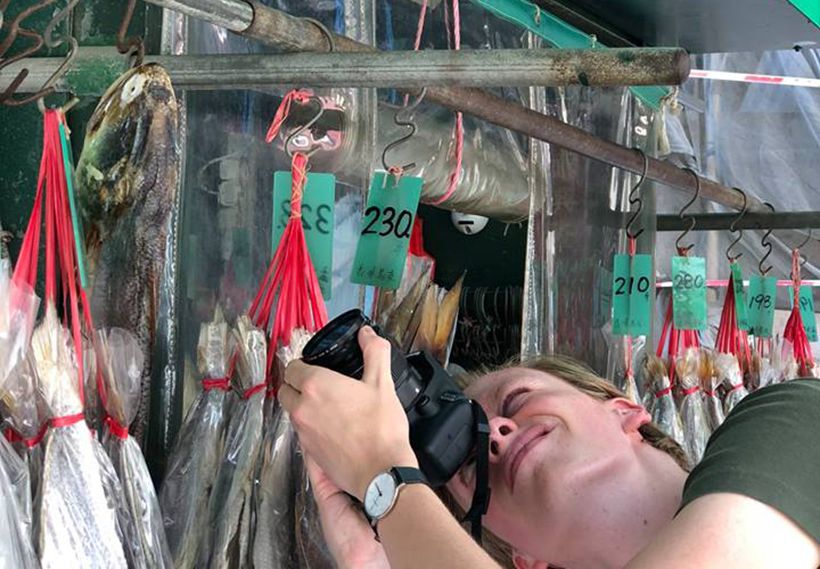
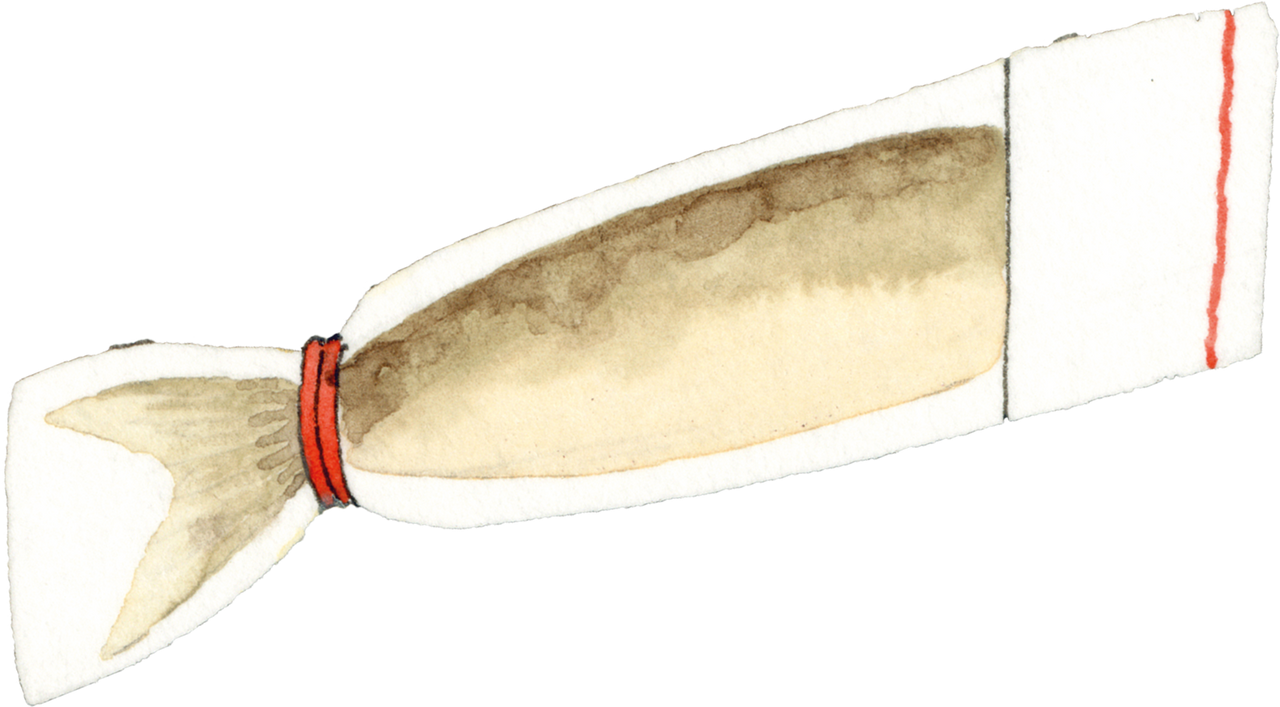
Story - Salted Fish Street
You can tell by the smell; this part of Sai Ying pun is also known as ‘salted fish street’. In what used to be a cluster of dried seafood shops, only one simple green shed with a 60-year-old signboard is still standing proud: Ng Wai Kee. Mr Ng was only nine years old when he walked all the way from his native Dongguan across the border to Hong Kong. He first made a living by picking up golf balls at Fanling Golf Course and then found a job at Mui Fong Street. He says: “Life was harsh in those days. I slept on a bed made out of two wooden planks. But I persevered and opened my own Ng Wai Kee the evening before I turned 20.”
You’d be lucky if the weather was dry, if it was raining you had to move the fish indoors.
On a good day Mr Ng would sell 20 mats. The bamboo drying mat is used as a measure unit and equals 100 fish. The shophouses in Mui Fong Street were like small factories. The fish was salted in the backrooms, dried on the balconies and sold out on the street. He says: “You’d be lucky if the weather was dry, if it was raining you had to move the fish indoors and if there were typhoons you had to start all over again.”
Tool - Iron Hook
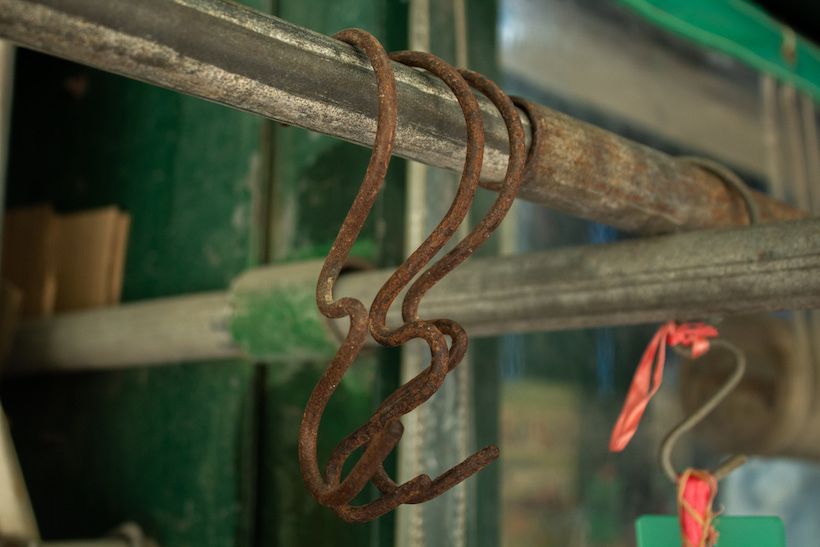
Buy - Fish Sauce
There’s only one thing you can get here and that’s salted fish. Not into fish, we’ve got you covered. Local designer Kay Chan is on a mission to rebrand salted fish by creating a sauce that suits the palate of the millennial generation. Get a bottle for just HK$88 at Form Society (HK$88)!
7. Mr Leung . Ng Wai Kee Rice
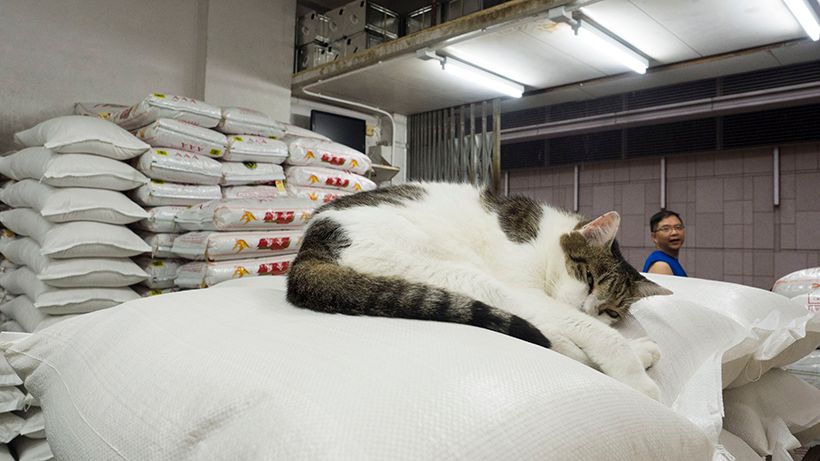
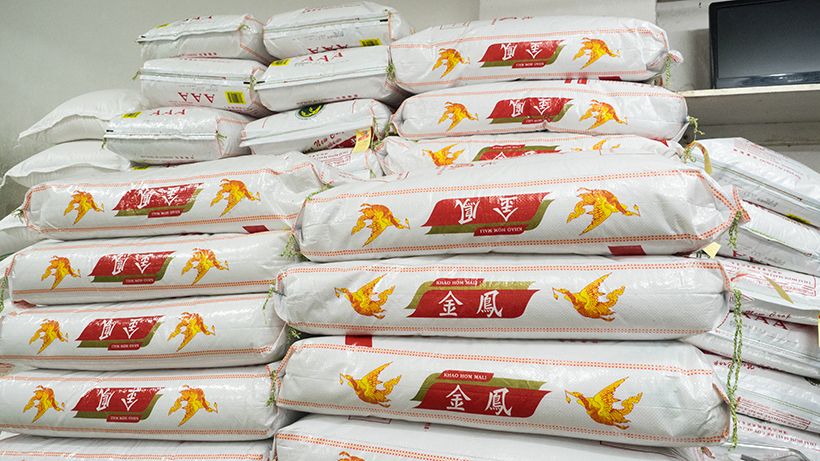
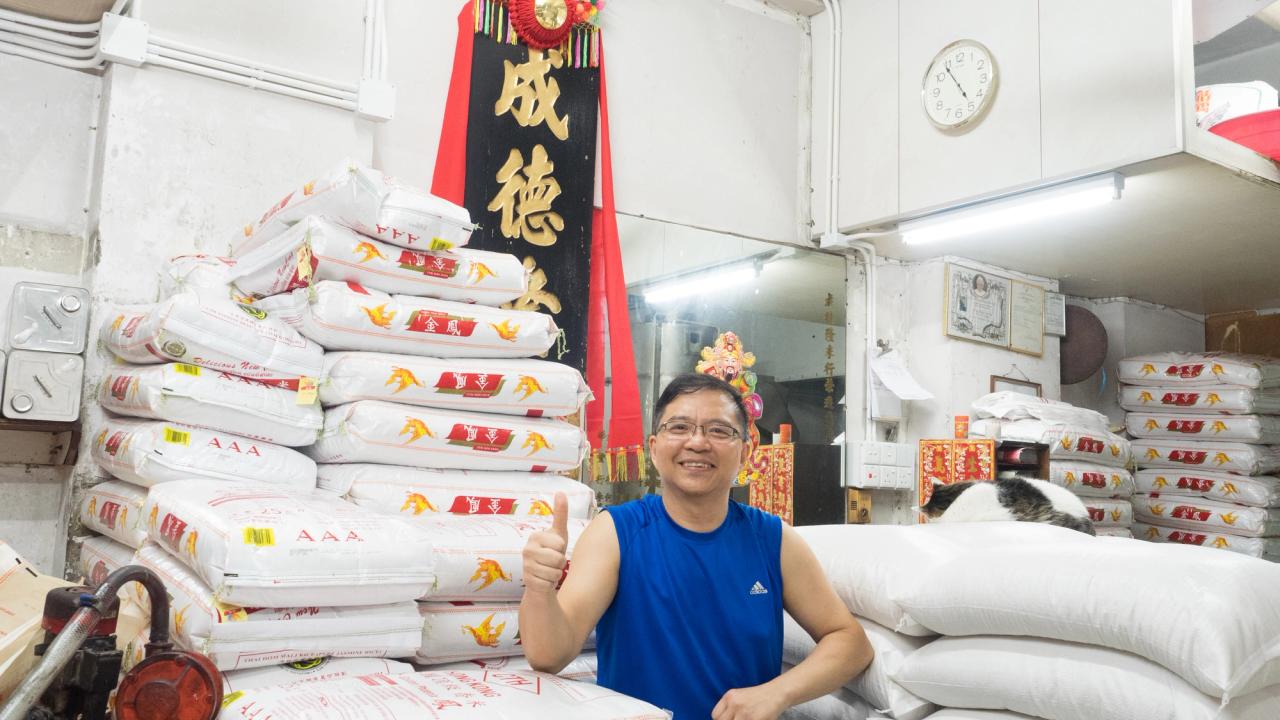

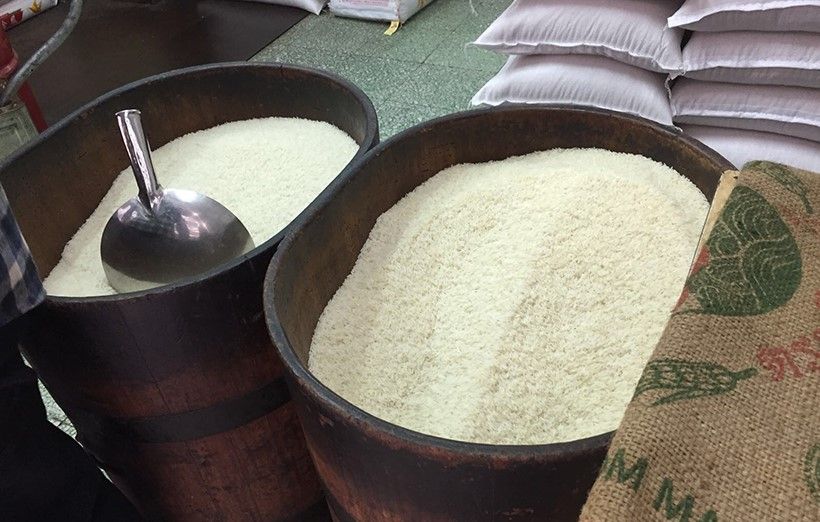
Story - Old and New Rice
Started in 1984, Sing Tak Lung is a wholesaler and typical neighbourhood ‘mom & pop’ shop at the same time. The Leungs are as happy selling small portion to an old lady as they are delivering a full cart with bags to a nearby restaurant. Mr Leung syncs the import of rice with the harvest time of his suppliers. Every November, they get newly harvested rice, stored till October. Over time the rice becomes drier, so called ‘old rice’. It means you need to add more water when cooking. Restaurants typically order a mix of new and old rice to maintain consistency in quality. The Sing Tak Lung mixer can hold 26 packs of 25 kg of rice at the same time.
There are many types of Thai rice. We only sell Golden Phoenix it’s the best quality one.
Tool - Mixing Machine
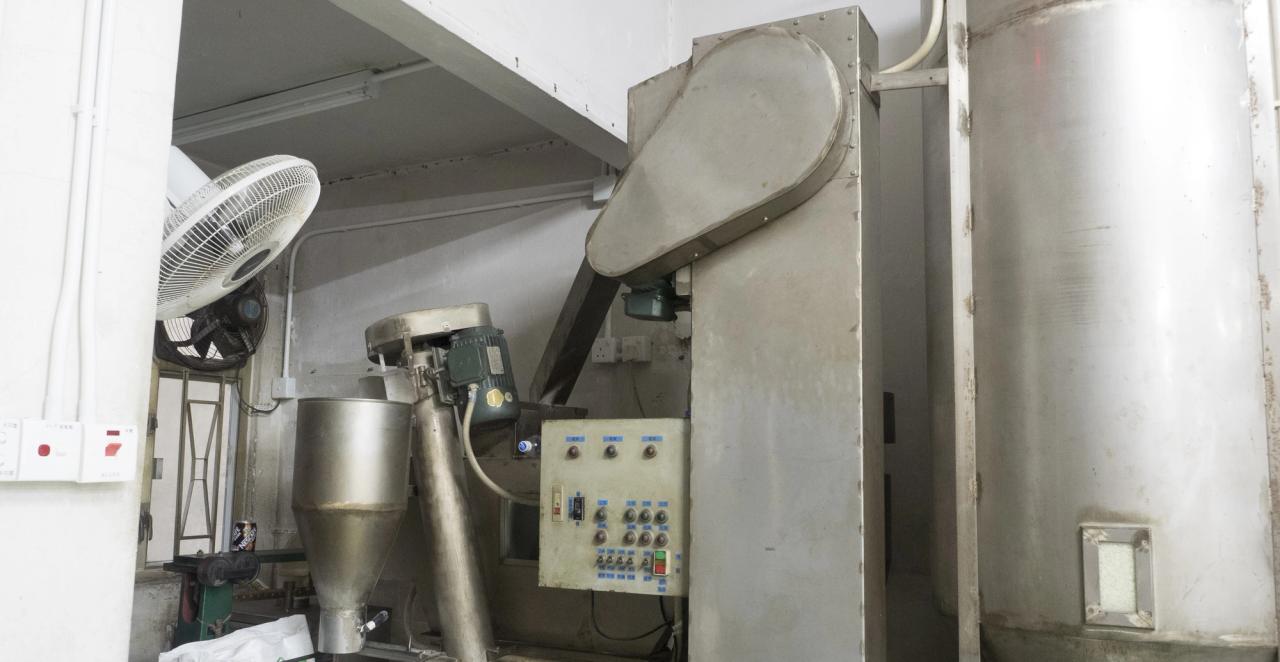
Buy - Rice
At Sing Tak Lung they have an expert opinion on rice and are happy to explain the differences in tastes and textures between the different grains. ‘There are many types of Thai rice. We only sell Golden Phoenix it’s the best quality one’ says Mr Leung. He’s also happy to give tips on how to cook rice to perfection and how to make the best congee. A place for people who take their rice seriously: not too chewy and not too soft.
Sing Tak Lung . 65 Third Street . 成德隆第 . 三街65號
8. Mr Yu . Yu Kwen Yick
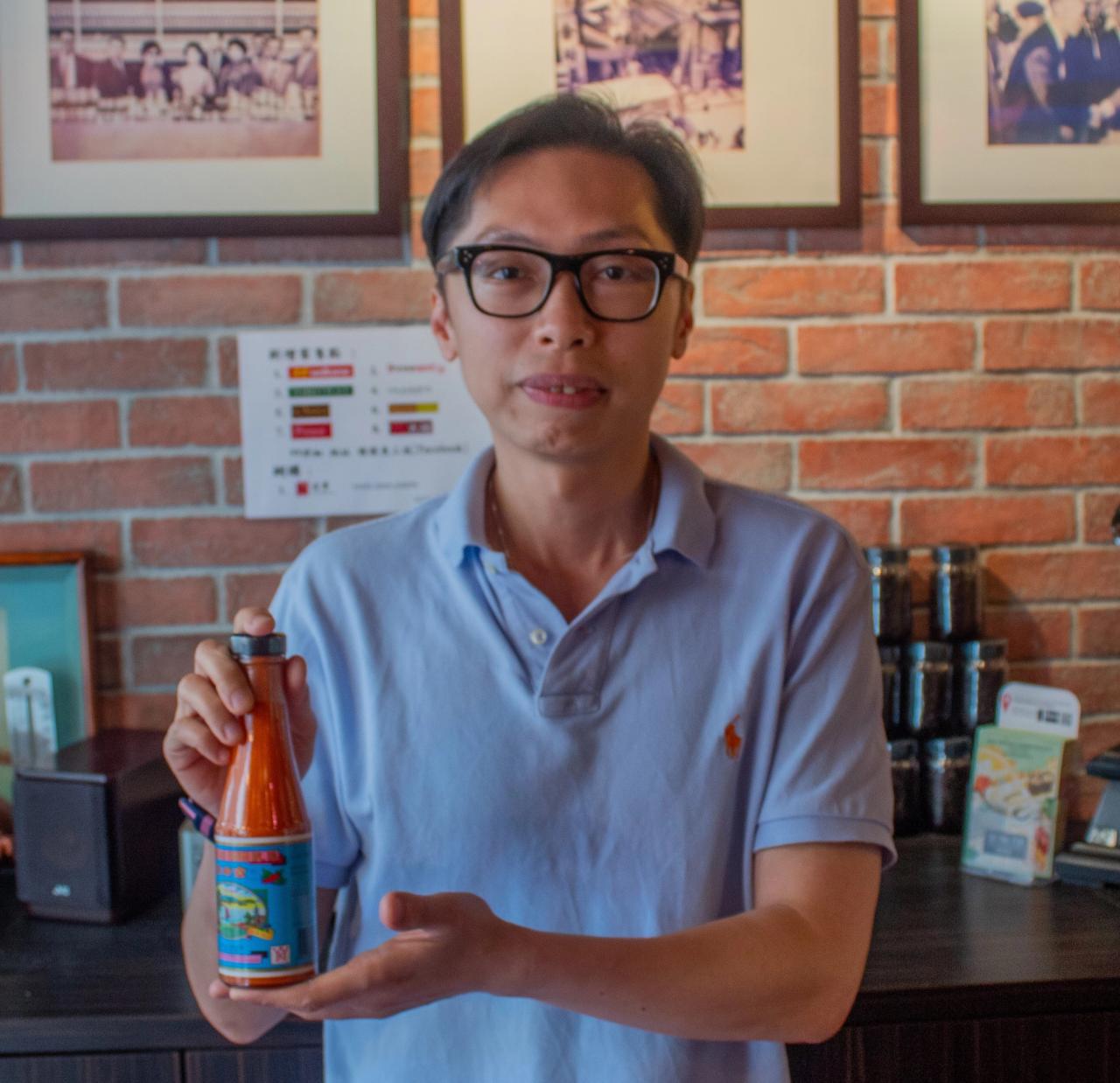
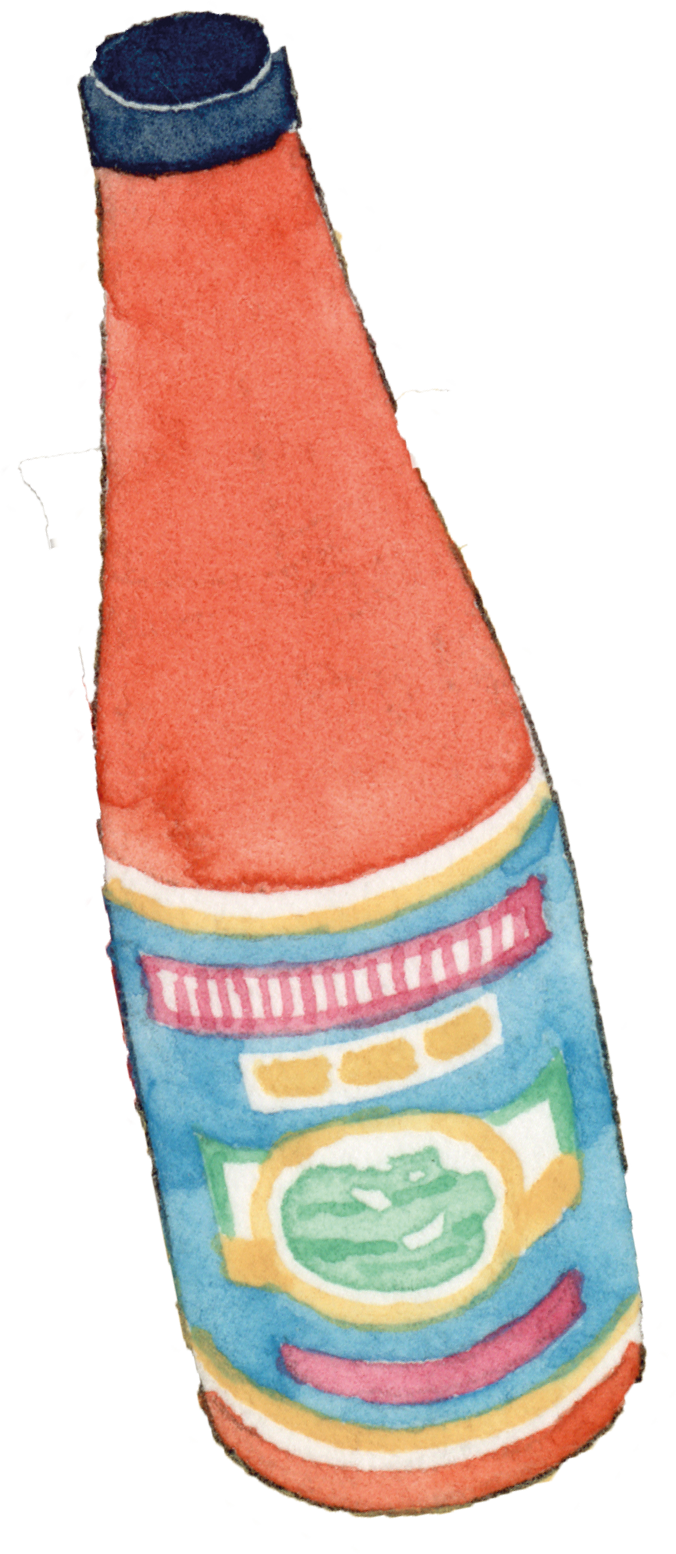


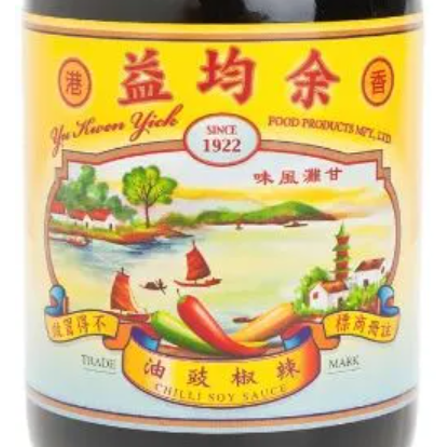
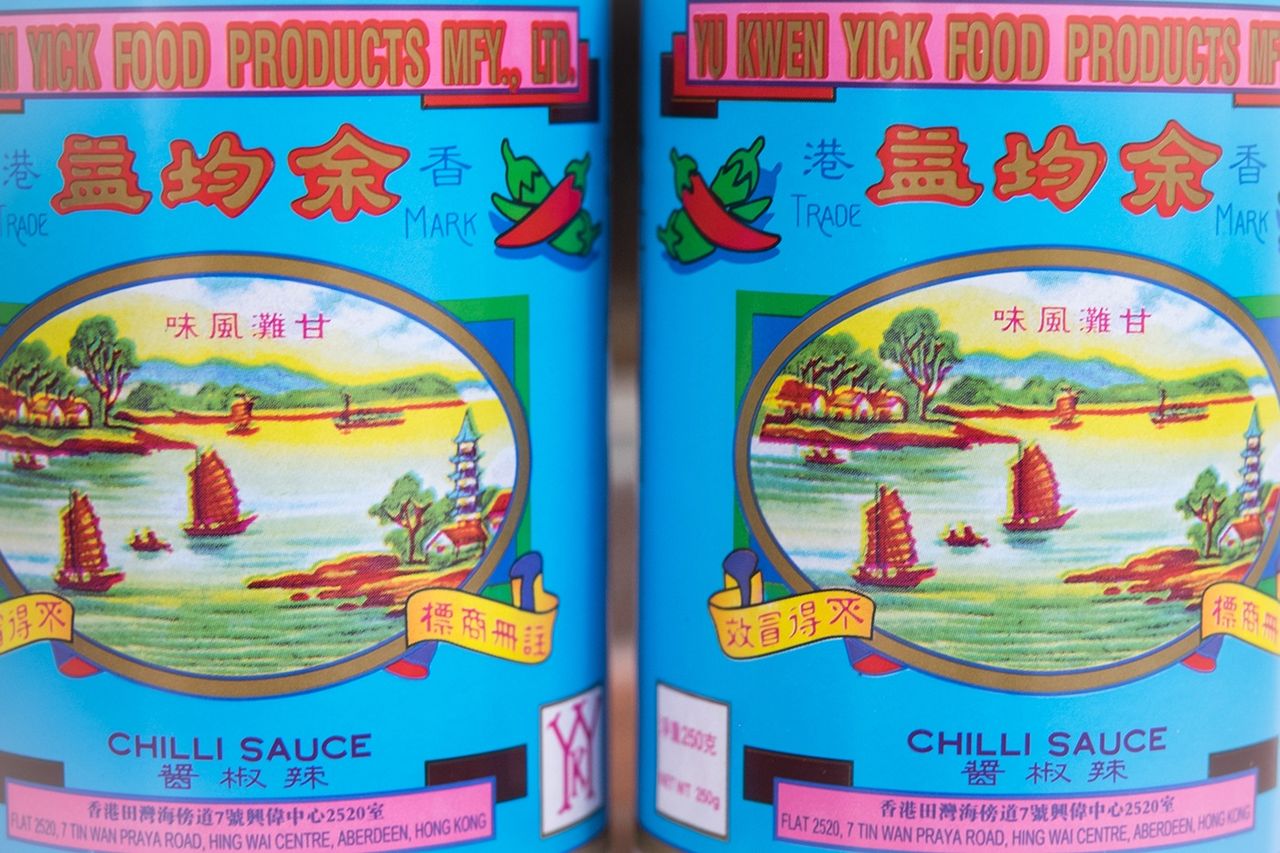
Story - Old Man Yu
Mr Yu started making chili sauce in the kitchen of a Sai Ying Pun shophouse in 1922. He sold the spicy sauce out on the streets carrying a bamboo pole with two buckets. In 1950 he managed to save enough money to open his own shop. Business took off from there. It’s the 3rd generation that now runs the factory in Aberdeen producing a range of sauces - oyster, sesame and lemon sauce - but chilli sauce is still the signature product. It’s so good, you can find it in restaurants all over the city and far beyond.
We do not add preservatives. My grandfather didn’t have it in the recipe, and we like to keep it like that.
"Sauce making is craftsmanship". To make chili sauce you need fresh chili, vinegar, sugar and salt. You mix them together and cook it. The factory uses the same old recipes and tools as in the early days. ‘We suggested the chefs to replace their tools, but they wouldn’t have any of it. This grinder has been here for ages and its speed is nice and slow so we can keep the flavour intact. We can at most produce 600-700kg in one morning.” says Antony Yu, Mr Yu’s grandson. They stir the sauce with wooden poles and use an old stone grinder. Each bottle takes about four to five days to produce. "We do not add preservatives. My grandfather didn’t have it in the recipe, and we like to keep it like that. It brings out the natural taste of the ingredients and is much healthier."
Mr Yu has become a local legend, and the Yu Kwen Yick brand so synonymous with Hong Kong that it inspired a cult following, a local craft beer and even its own cocktail. At Alvy’s, a popular bar and restaurant in Kennedy Town, bartender Saheb happily mixes us a Bunny Mary, garlic infused vodka, fresh carrot juice and of course a dash of chili sauce. They also created a special Yu Kwen Yick marinade for their buffalo wings. "Yu Kwen Yick is a very playful sauce" Anthony agrees.
Tool - Grinder
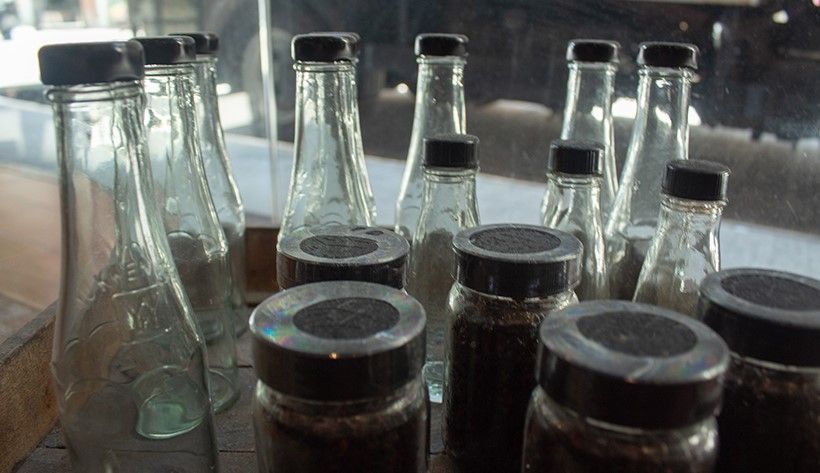
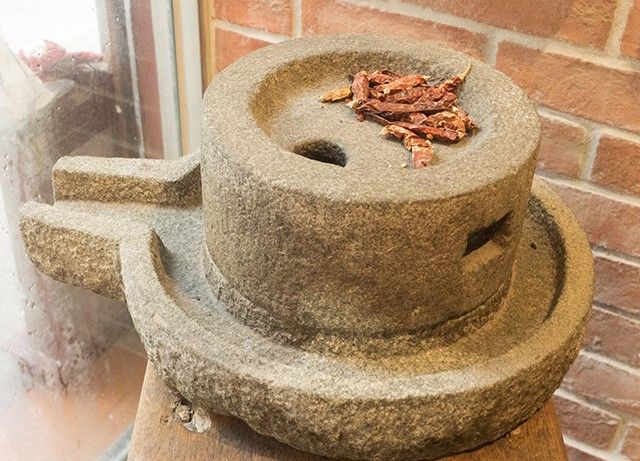
Buy - Chilli Sauce
Pick up a bottle of here at the Sai Ying Pun shop or buy it online. The unique spicy and sour taste is popular year-round but at Chinese New Year things get busy as it pairs well with the obligatory auspicious turnip cakes. Anthony - modest as he is - likes his chili sauce best on ham & egg sandwich.
Yu Kwen Yick . 66A Third Street . 余均益 . 第三街66號A
Mapping the Soul of Sai Ying Pun
What did we learn from these eight proud craftsmen?
- Skill is timeless . Ancient recipes and traditional methods are passed on from generation to generation. The skills of today are based on decades of experience from old masters.
- Natural Creators . craftsmen are not afraid of re-inventing their products to cater to a new generation.
- Spirit of Place . Local products for loyal customers. The craftsmen have a deep connection to the neighbourhood.
Explore Sai Ying Oun through thier with this iDiscover walking trail. More than just a travel guide, it is a community guide to a neighbourhood, created by locals who feel proud of their heritage, culture and identity. They suggested their long-time favourite places, put them on the map and shared them with the world.
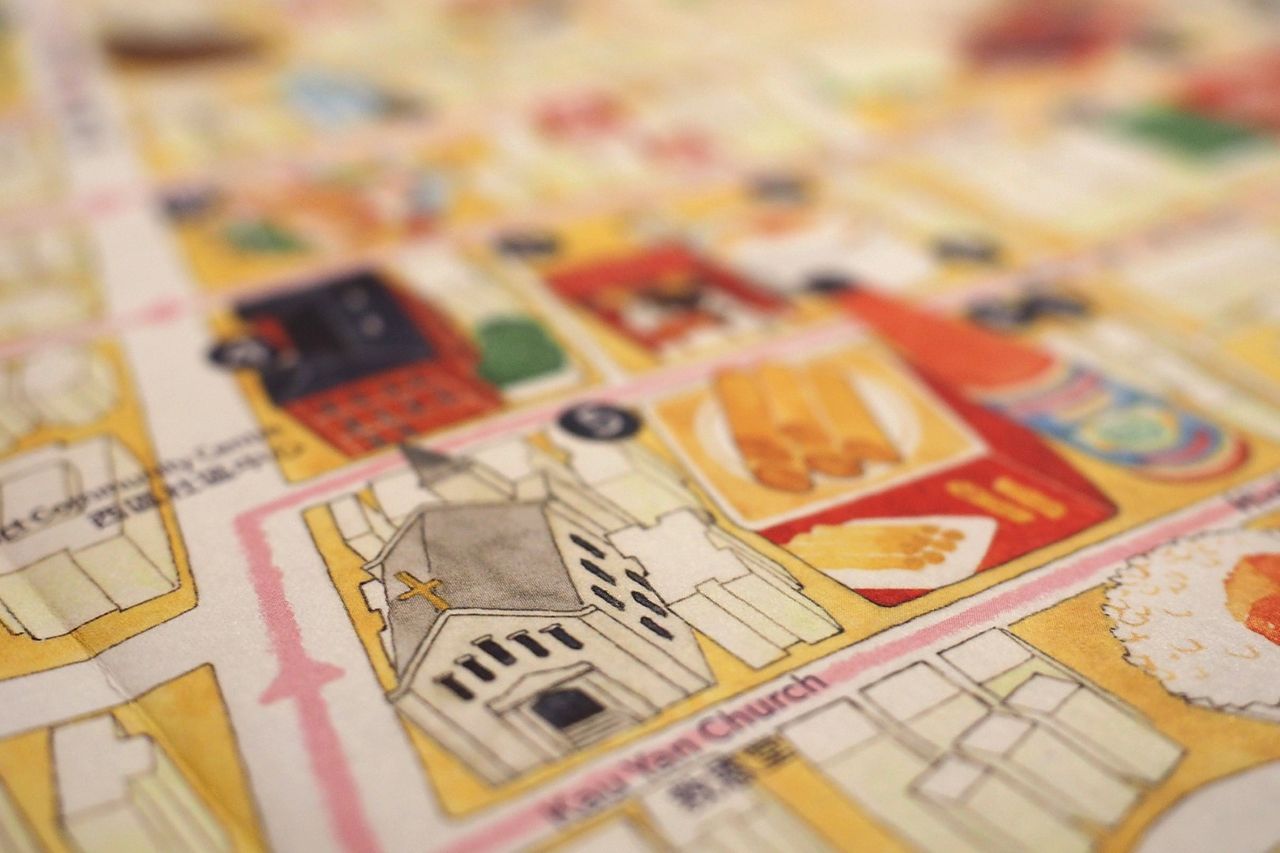
The historical Sai Ying Pun community has survived waves of rapid urbanization, for generations of daring, innovative and diligent locals, with a spirit of craftsmanship, forged a strong root-deepening place identity.
To make the map of Sai Ying Pun we worked together with some amazing local collaborators:
- Local curators – We put residents in role of curators. All credits go to our local partners Caritas Mok Cheung Sui Kun Community Centre and Magic Lanes Community Design Studio and their neighbours and friends. It’s their favourite places that make this map what it is, a true tribute to the spirit of place. Also a massive word of thanks to the students of CUHK School of Continuing and Professional Studies (CUSCPS) who helped recording the stories, we could not have done without them!
- Local designers – The Sai Ying Pun map is hand drawn by local illustrator Carmen Ng. She loves paper, watercolour and ink and her style has really brought the unique craft culture of Sai Ying Pun to life.
- Local sponsors – This neighbourhood guide is crowdfunded through Sparkraise! This was a first for us. It was great to see locals chipping in a bit of money to get their neighbourhood a place on the map…. Literally!
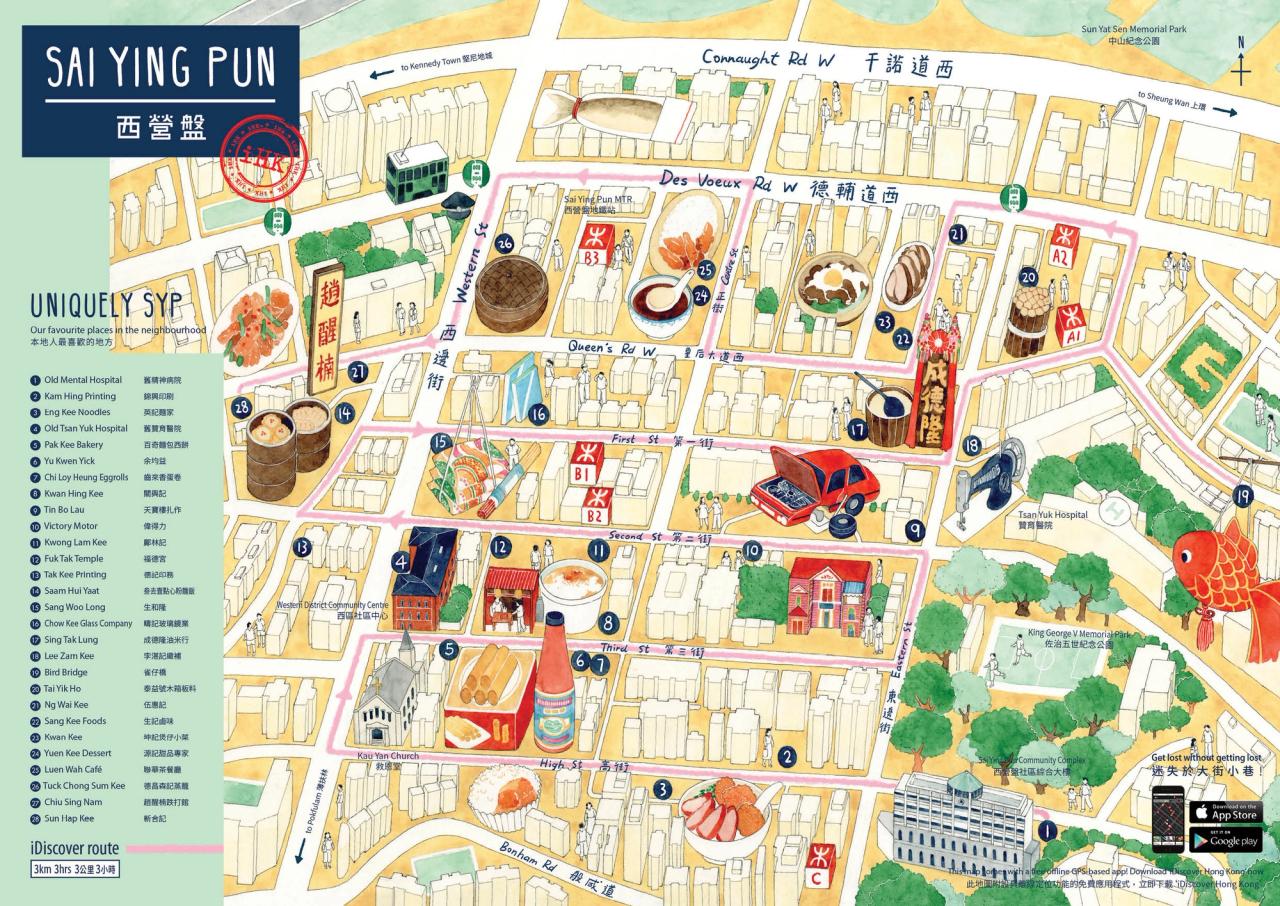
Credits
Magic Lanes

Powered by

Designed by

About
Magic Lanes
“Magic Lanes” is a community design studio in Sheung Fung Lane. Their mission is to reweave the social fabric and turn the small lane into a place for vibrant street life, an inspiring initiative from the joint Caritas and CACHe. “ 明愛與長春社聯手策劃「重塑西營盤―公共空間再生計劃」,在西營盤常豐里以一刻社區設計館為基礎,開展重塑社區空間的工作,促進居民參與,引發想像,凝聚共識,建設社區,再現街道生活,但求營造一個可以重覓人情的空間
www.facebook.com/magiclanesstudioUrban Renewal Fund Urban Renewal Fund
This project was part of an inclusive community placemaking initiative in Sai Ying pun by Caritas Community Centre supported by the Urban Renewal Fund.
www.sparkraise.comCarmen Ng
Hong Kong born painter and illustrator who loves paper, watercolour and ink. She has visualised the unique craft culture of SYP in her signature hand-drawn style. 香港出生的插畫家,以水彩和墨水作畫。 她以手繪風格展現了西營盤獨特的工藝文化。
www.carmen-ng.com